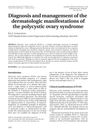TLDR Steroid cell tumors in the ovary are rare, can cause hormone-related symptoms, and require surgery.
Steroid cell tumors (SCTs) of the ovary are rare, accounting for less than 0.1% of all ovarian tumors, and can produce androgenic symptoms such as hirsutism, hair loss, and amenorrhea. This case report described a 16-year-old girl with a unilateral, benign SCT presenting with rapid onset of virilization symptoms over 6 months. Her testosterone levels were elevated, and imaging revealed a 6 cm ovarian mass. Surgical excision of the tumor led to regression of symptoms within 4 months. The case highlighted the importance of considering SCTs in young women with sudden androgen excess and the role of immunohistochemical testing in diagnosis. Despite the benign nature of most SCTs, pathologic evaluation is crucial due to the risk of malignancy.
 63 citations
,
March 2011 in “Clinical Endocrinology”
63 citations
,
March 2011 in “Clinical Endocrinology” Evaluate postmenopausal women with high androgen levels using medical history, physical exams, lab tests, and imaging to manage health risks.
502 citations
,
February 2008 in “The Journal of Clinical Endocrinology & Metabolism” Treat significant hirsutism with medication and hair removal; use birth control pills first, adding antiandrogens if needed.
 7 citations
,
October 2019 in “Case reports in endocrinology”
7 citations
,
October 2019 in “Case reports in endocrinology” A young woman's symptoms suggested PCOS, but tests and surgery confirmed and treated a rare ovarian tumor, resolving her condition.
 97 citations
,
July 2006 in “Dermatologic therapy”
97 citations
,
July 2006 in “Dermatologic therapy” The document concludes that accurate diagnosis and personalized treatment are important for skin problems in women with PCOS.
 3 citations
,
July 2019 in “Case Reports in Obstetrics and Gynecology”
3 citations
,
July 2019 in “Case Reports in Obstetrics and Gynecology” A young woman's rare ovarian tumor was successfully removed, improving her hormonal symptoms.
 10 citations
,
May 2009 in “Cases Journal”
10 citations
,
May 2009 in “Cases Journal” A woman's masculine symptoms were caused by an ovarian tumor, which improved after surgery.
 27 citations
,
January 2013 in “Indian Journal of Dermatology, Venereology and Leprology”
27 citations
,
January 2013 in “Indian Journal of Dermatology, Venereology and Leprology” PCOS is a complex disorder managed by treating symptoms and requires a team of specialists.







